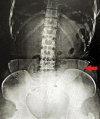Isolated Unilateral Hydrosalpinx Torsion in a Post-Tubal Ligation Patient: A Case Report and Review of Literature
- PMID: 38633976
- PMCID: PMC11021850
- DOI: 10.7759/cureus.56351
Isolated Unilateral Hydrosalpinx Torsion in a Post-Tubal Ligation Patient: A Case Report and Review of Literature
Abstract
Isolated tubal torsion of the hydrosalpinx is a rare occurrence with a varied clinical presentation, presenting a diagnostic challenge. We present a case involving the isolated torsion of the right hydrosalpinx in a 33-year patient with a history of bilateral tubal ligation who presented with an acute abdomen. Based on ultrasound and clinical findings, an initial diagnosis of ovarian torsion was considered. However, escalating pain severity led to diagnostic laparotomy, revealing torsion in the right hydrosalpinx. Subsequent right salpingectomy was done, and as the patient had undergone tubal ligation, preventive left salpingectomy was also performed. Both ovaries were preserved. The patient experienced an uneventful recovery. A literature review uncovered fewer than 50 reported cases of unilateral or bilateral isolated fallopian tube torsion post-tubal ligation. This case underscores the diagnostic challenges associated with isolated tubal torsion and emphasizes the crucial role of early surgical intervention in preventing morbidity and preserving ovaries.
Keywords: fallopian tube torsion; hydrosalpinx; ischaemic necrosis; salpingectomy; undiagnosed abdominal pain.
Copyright © 2024, Jajoo et al.
Conflict of interest statement
The authors have declared that no competing interests exist.
Figures






References
-
- Clinical manifestations in women with isolated fallopian tubal torsion; a rare but important entity. Lo LM, Chang SD, Lee CL, Liang CC. Aust N Z J Obstet Gynaecol. 2011;51:244–247. - PubMed
-
- Remarks on salpingitis and some of its effects. Sutton JB. https://ia600708.us.archive.org/view_archive.php?archive=/22/items/cross... Lancet. 1890;6:1206–1209.
-
- Torsion of the fallopian tube. Ferrera PC, Kass LE, Verdile VP. Am J Emerg Med. 1995;13:312–314. - PubMed
-
- Isolated torsion of the fallopian tube: a case report and review of the literature. Antoniou N, Varras M, Akrivis C, Kitsiou E, Stefanaki S, Salamalekis E. https://pubmed.ncbi.nlm.nih.gov/15491073/ Clin Exp Obstet Gynecol. 2004;31:235–238. - PubMed
-
- Isolated fallopian tube torsion: a rare but important event for women of reproductive age. Comerci G, Colombo FM, Stefanetti M, Grazia G. Fertil Steril. 2008;90:1198–1195. - PubMed
Publication types
LinkOut - more resources
Full Text Sources
